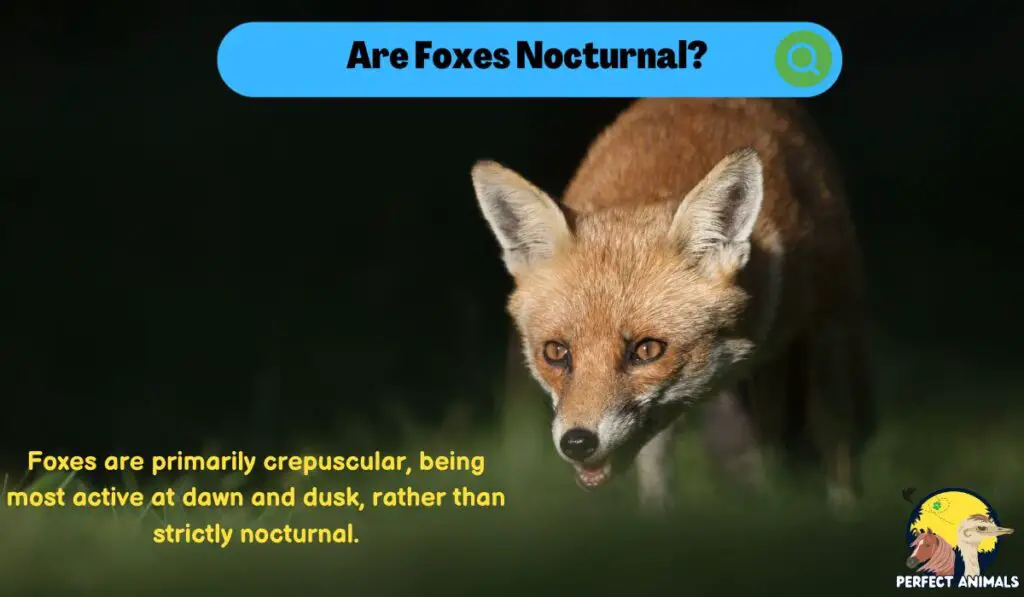Foxes are ubiquitous wildlife that can be found on nearly every continent.
With their bushy tails and pointed ears, these medium-sized canids are a common sight.
But when are they most active? Are foxes primarily nocturnal creatures that come out at night? Or do they prefer to hunt and forage during the daylight hours?
In this article, we’ll take a look at the activity patterns of different fox species to determine if they are strictly nocturnal or if they can adapt their schedules.
We’ll examine the behavior of wild foxes as well as the differences between types of foxes.
Read on to learn whether various foxes are predominantly active at night or if they routinely venture out in the daytime as well.
Are Foxes Nocturnal?
When examining the activity patterns of foxes, it’s important to note that not all fox species are the same.
Foxes can actually be classified into two main behavioral categories – nocturnal or crepuscular.
Nocturnal foxes are most active at night and spend daylight hours resting in dens or concealed areas.
The red fox is an example of a fox that is primarily nocturnal, doing most of its hunting and foraging after dusk.

This allows them to take advantage of low-light conditions when prey may be more vulnerable.
Other fox species are considered crepuscular, meaning they are most active during twilight hours at dawn and dusk.
The gray fox falls into this category, preferring to hunt during these transitional periods that offer ideal lighting and temperatures.
Their activity peaks as the sun rises and sets when both nocturnal and diurnal prey may be active.
So while some foxes like the red fox conform to a nocturnal schedule, others like the gray fox adopt a crepuscular pattern.
Their activity levels depend on the availability of prey and environmental factors rather than a strictly nocturnal or diurnal preference.
Related Article – Foxes in Tennessee
What Do Foxes Do At Night?
For nocturnal fox species like the red fox, the nighttime hours are their prime time to hunt and be active.
Under the cover of darkness, red foxes will venture out of their dens and patrol their territories in search of food.
Red foxes rely heavily on their excellent sense of hearing to locate prey at night.
Big, movable ears give them an advantage in pinpointing the faint sounds of scurrying mice, rabbits, and other small mammals.
While not as sharp as owl vision, foxes also have decent night vision afforded by a tapetum lucidum behind the retina.
In addition to hunting, red foxes use the overnight hours to patrol the boundaries of their territory and scent marks to ward off intruders.
Vocalizations like barking and “gekkering” calls can communicate warnings and keep rivals away. They may cache excess food to retrieve and eat later.
Red foxes are opportunistic and consume fruits, insects, birds, and other food sources.
But rodents tend to make up a significant portion of their nighttime diet.
Overall, the dark and cooler temperatures make the night the ideal time for nocturnal red foxes to hunt and conduct other behaviors needed for survival.
Is It Normal to See a Fox During the Day?
While foxes like the red fox are primarily nocturnal, it is not uncommon to spot them during daylight hours as well.
This daytime activity can be normal for certain fox species and instances.
For crepuscular species like the gray fox, daytime activity is routine as they hunt at dawn and dusk.
But strictly nocturnal red foxes will also occasionally venture out in the daytime.
This often occurs during the breeding season, when foxes may roam outside of their dens more often to find mates.
Foxes that live near human habitats may get accustomed to daytime activity and sounds.
Hungry foxes may get bolder and risk daytime excursions into yards or parks to search for food.
And mother foxes need to hunt more often when they have young kits to feed.
It is also not unusual for foxes to be active during the day in the summer when they have young to care for.
Some nocturnal foxes may become diurnal in regions where night hunting is riskier due to larger predators.
So while most fox sightings occur at night, seeing a fox out in daylight hours can be situationally normal behavior for these adaptable animals.
It does not necessarily mean the fox is rabid or unhealthy.
You May Also Like – Discover 12 Crabs in Florida
What To Do if a Fox Sees You?
If you encounter a fox while out during the day or night, the fox will likely detect you before you notice it.
Foxes have excellent senses of smell, sight, and hearing compared to humans.
So what should you do if you spot a fox or realize a fox has seen you?
First, remain calm and avoid sudden movements. Do not run or scream. This may trigger a fox’s prey drive and cause them to give chase out of instinct.
Also, do not corner the fox or prevent their ability to escape.
Maintain a safe distance and act non-threatening. In most cases, the fox will perceive you as a potential threat and flee immediately.
They prefer to avoid confrontations. Give the fox clear exit routes.
You can deter the fox by making loud noises, waving your arms, or throwing objects near but not directly at the fox.
However, if the fox does not flee and exhibits bold behavior, respraying with vinegar, garden hoses, or pepper spray may be warranted.
Generally, healthy foxes want to avoid interactions with humans when possible.
By giving them adequate space and escape routes, foxes will retreat and maintain their natural wariness of people.
Are Foxes Afraid of Dogs?
Foxes and dogs overlap in habitat and often encounter one another, which brings up the question – are foxes afraid of dogs?
The evidence suggests that foxes exhibit caution around domestic dogs, but their fear response depends on various factors.
In general, foxes tend to avoid confrontations with dogs whenever possible.
Dogs can chase foxes out of their territories and pose a mortal danger, especially larger dog breeds. Even small dogs can harass and stress wild foxes.
However, urban foxes in closer proximity to humans and dogs may become desensitized and bolder around canines.
Hungry foxes may also take more risks scavenging dog food or raiding trash cans near homes with dogs.
Foxes are very adaptable and can learn dogs’ schedules and when it’s safer to pass through a yard.
Their fear levels decrease if dogs are confined indoors, in kennels, or on leashes as opposed to roaming free.
Foxes also retain their boldness during mating season.
Mother foxes are particularly fiercely defensive of their dens and kits.
They may try to lure dogs away by using distress calls. In rare cases, they may attack dogs that get too close to their litters.
So while not truly afraid of dogs, foxes do tend to exhibit wariness and caution around canines.
Their survival instincts make them inclined to avoid close encounters with dogs whenever possible.
You May Also Like – Armadillos In Tennessee
Final Thoughts
When looking at the activity patterns of foxes, it’s clear these adaptable canids are not exclusively nocturnal or diurnal.
Fox behavior and schedules can vary greatly depending on species, habitat, breeding cycles, and other factors.
While certain foxes like the red fox are primarily nocturnal due to their excellent night vision and ability to hunt in darkness, others like the gray fox are crepuscular and most active in twilight hours.
Even strictly nocturnal species may occasionally venture out in daylight when necessitated by hunger or mating requirements.
So while many foxes conduct a great deal of their hunting under the veil of night, they display flexible behaviors to take advantage of prey availability in daylight hours as well.
By accommodating their activity patterns to fluctuations in food sources and seasons, foxes reveal their survival skills and ability to thrive in diverse environments.
Their unique skills allow them to find sustenance and avoid danger both night and day.
Resources – (for further reading)
BBC Wildlife Magazine – Understand fox behaviour – Discover Wildlife
The Humane Society of the United States – What to do about foxes
Britannica – Red fox | Diet, Behavior, & Adaptations

Sarah has years of experience working as a zookeeper. She has cared for a wide variety of animals, from primates to big cats. Her passion for animals extends beyond her profession, as she dedicates her free time to writing about wildlife and their conservation.

